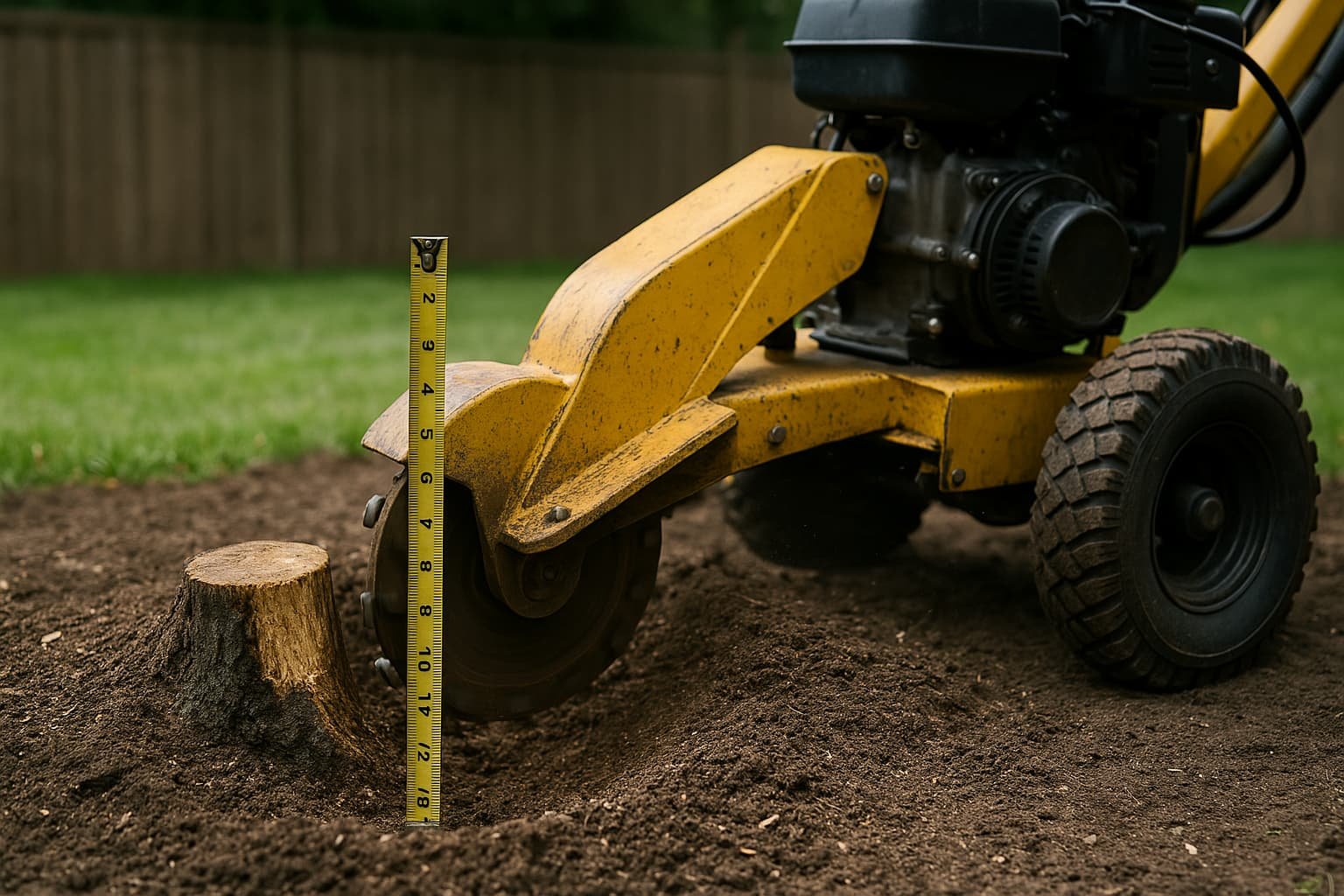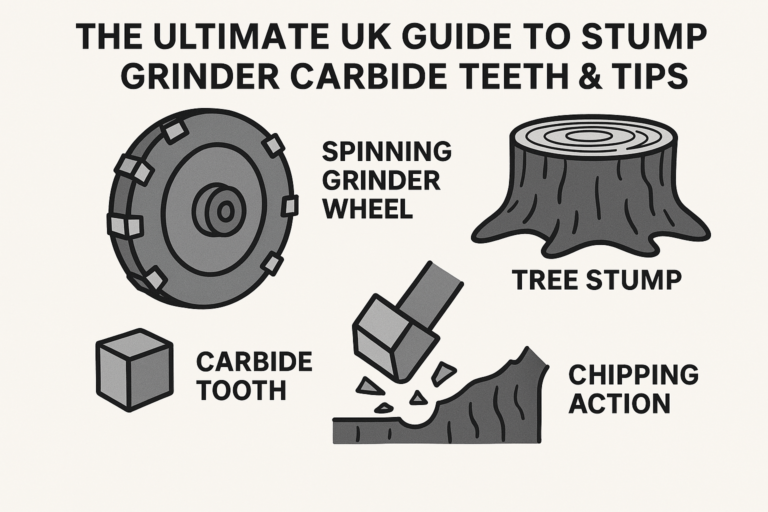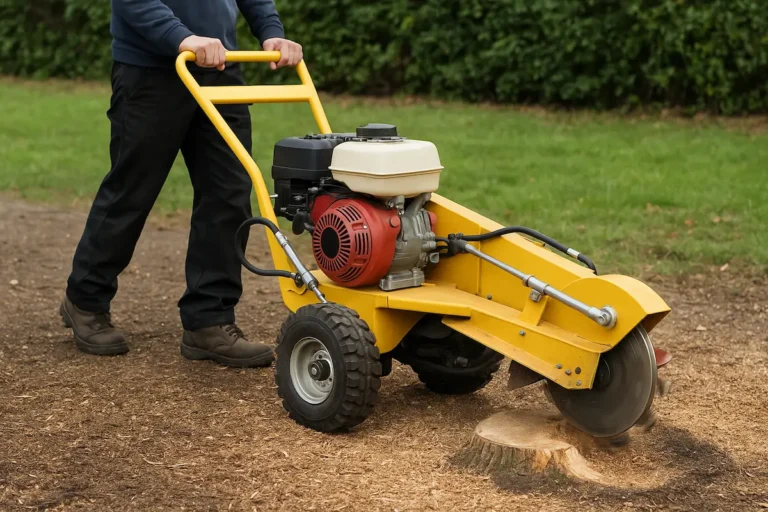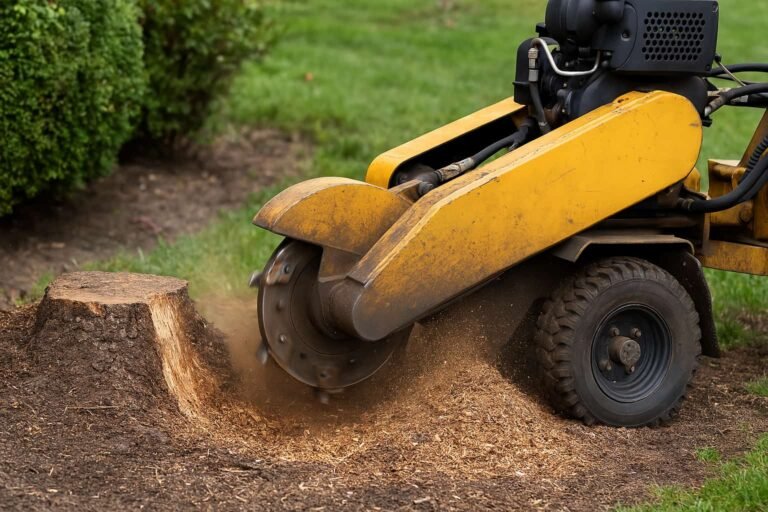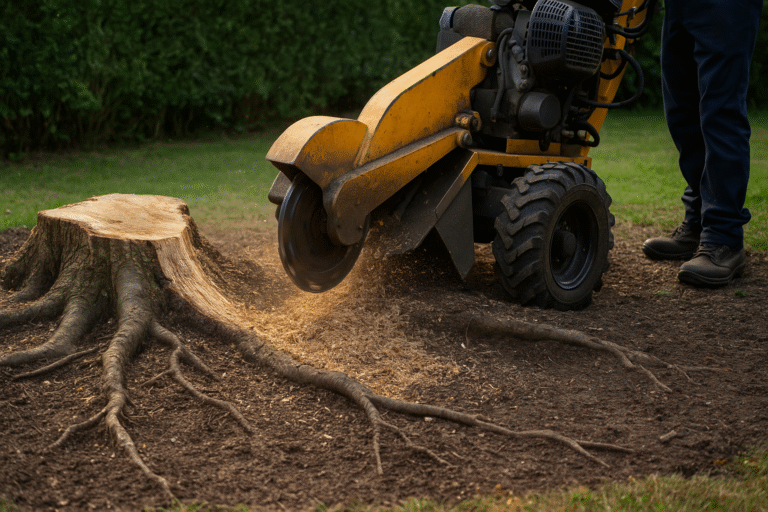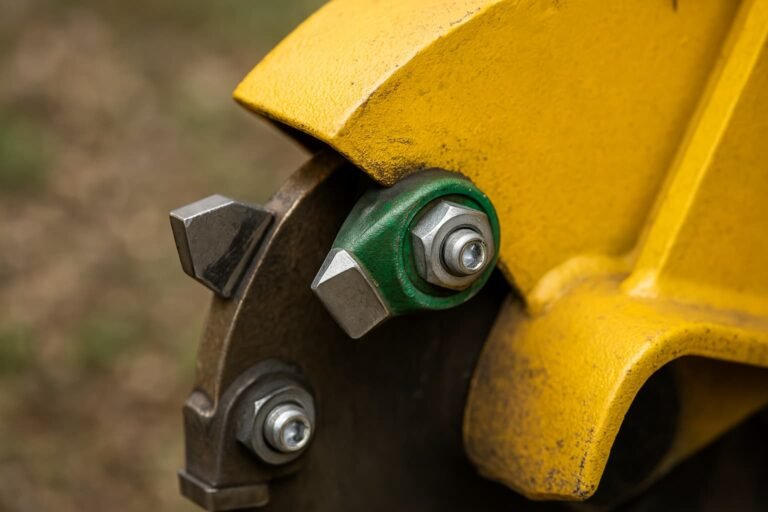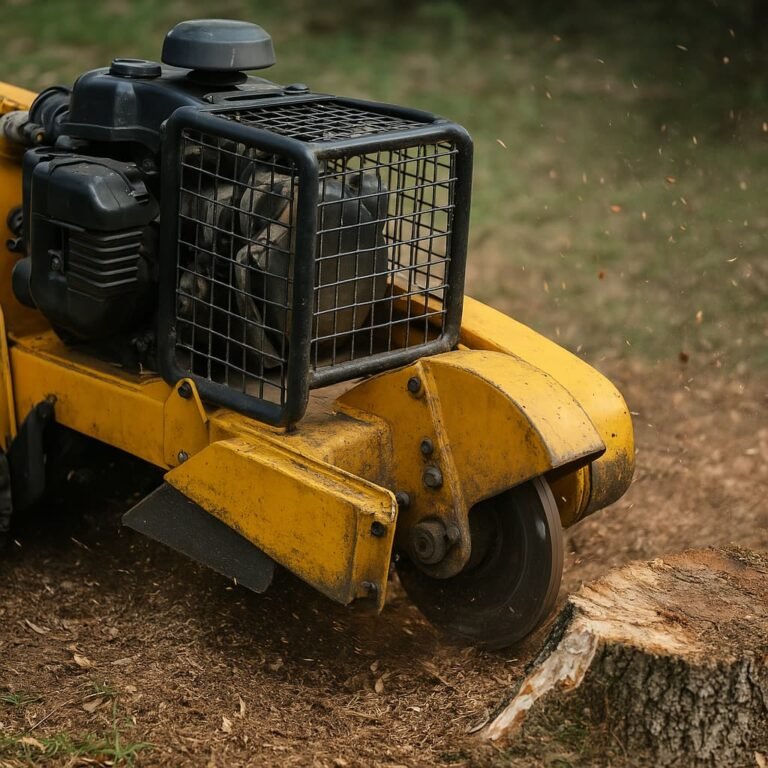Mastering Stump Grinder Cutting Depth: Your Essential UK Guide
Stump grinder cutting Depth means how far below the ground the machine grinds a tree stump.
Getting this depth right is essential for what you want to do next in your garden.
This guide explains how deep you need to grind for different jobs.
It helps you choose the right hire grinder for your task.
Key Takeaways: Stump Grinding Depth
- The required cutting depth depends directly on your future plans for the area.
- Simple lawn repair (4-8 inches) needs the least depth.
- Gardens/flowerbeds require deeper grinding (8-12+ inches) for healthy plant growth.
- Replanting trees or undertaking construction demands the most depth (12-24+ inches) to remove obstructions and prevent issues.
- Insufficient depth can lead to regrowth, uneven ground, or construction problems.
What Exactly is Stump Grinder Cutting Depth?
Let’s look closer at what cutting Depth means.
Defining Cutting Depth: Measuring Below Ground Level
Cutting Depth is the distance from the earth level down to the grinder’s lowest point.
Think of it like digging a hole where the stump was.
The cutting depth tells you how deep that hole will be.
We usually measure this Depth in inches or centimetres.
It always refers to the distance below the surrounding soil level.
Zero Depth means the stump is only ground level with the dirt.
Why Simply Grinding Flush Isn’t Enough
Just grinding a stump flat with the ground often causes problems later.
The central stump wood might be gone from the surface.
But the thick base and large roots just below are still there.
These leftover bits can get in the way.
They can stop grass from growing properly.
They might make the ground uneven over time.
Some tree types can even grow back from shallow roots.
So, you need to grind below the ground level.
The correct Depth depends entirely on your plans for that spot.
Why Cutting Depth is Non-Negotiable for Successful Stump Removal
Choosing the correct cutting depth is key for a few big reasons.
It affects regrowth, future gardening, and building work.
Prevent Stubborn Tree Regrowth (Especially Willows and poplars)
Some trees are very determined to grow back.
Trees like willows, poplars, and locusts can sprout new shoots.
This often happens if you only cut the stump near the surface.
Grinding the stump deep underground makes regrowth much harder.
It removes the leading energy stored in the stump.
A depth of 6 to 12 inches helps stop most regrowth.
For very persistent trees, grinding even deeper is better.
Bold Stat: Failing to grind deep enough on certain species can lead to repeated sprouting.
Prepare Ground Effectively for Future Landscaping
What do you want to do with the area after the stump?
Your plans decide the needed cutting Depth.
If you want to grow grass, a shallower depth might work.
But for flowerbeds or planting shrubs, you need to go deeper.
This removes more wood and roots.
It makes digging and planting much more straightforward.
It gives new plants space to grow their roots properly.
An insufficient depth can make future gardening frustrating.
Avoid Obstructions for Construction Projects
Are you planning to build something over the old stump area?
This could be a patio, a path, a driveway, or even a small structure.
Leftover stump wood or large roots underground can cause serious issues.
They create hard spots that are difficult to dig through.
They can interfere with laying foundations or base layers.
Over time, the wood will rot away.
This rotting wood creates empty spaces underground.
The ground above can sink, causing cracks or uneven surfaces.
Patios can become uneven, and driveways might crack.
For building work, a deep grind is essential to clear obstructions.
How Deep Should You Grind? Matching Depth to Your Plans
The perfect cutting depth depends on your specific project.
Here’s a guide to help you decide:
For Laying New Turf/Grass: Aim for 4-8 Inches Below Grade
You don’t need to go extremely deep if you want the lawn where the stump was.
Grinding 4 to 8 inches (10-20 cm) below ground level is usually fine.
This removes the main bulk of the stump wood visible at the surface.
It gets rid of enough material to allow you to add topsoil.
You can then lay turf or sow grass seed over the top.
The remaining deeper roots will decompose slowly over the years.
This Depth usually prevents the old stump location from interfering with mowing.
Key Point: 4-8 inches is often adequate for simple lawn repair.
For Creating Flowerbeds or Gardens: Target 8-12+ Inches Deep
Go more profound if you plant flowers, vegetables, or small shrubs.
Aim for 8 to 12 inches (20-30 cm).
This deeper grind removes more of the stump and upper root system.
It makes the soil much easier to work with when you dig.
It removes woody obstacles that could block new plant roots.
It allows you to mix in compost and adequately prepare the garden bed.
Healthier plants need good root space, free from old wood.
Tip: More Depth means better soil conditions for your plants.
For Replanting Trees or Large Shrubs: Require 12-24+ Inches Deep.
Planting a new tree or a large shrub where an old one stood needs the most Depth.
You generally need to grind 12 to 24 inches (30-60 cm) deep, sometimes more.
This deep grinding removes the core of the old stump.
It also chews away many of the large, anchoring roots.
This gives the new tree’s root ball enough space to fit.
It prevents the old roots from competing with the new tree for water and space.
It helps the new tree establish itself as strong and healthy.
Crucial: Replanting success often depends on intense stump removal.
For Construction (Patios, Drives, Foundations): Need 12-18+ Inches Deep
Building projects need a solid, stable base.
Stumps and roots left too close to the surface cause problems.
You need to grind down 12 to 18 inches (30-45 cm) or more.
The exact Depth might depend on your specific construction needs.
Ask your builder or landscaper for their recommendation.
This Depth ensures you remove obstructions that could compromise the base layers.
It prevents future sinking or cracking as the remaining wood decays.
Safety First: Always check for underground pipes or cables before deep grinding. Use services like Dial Before You Dig.
Summary Table: Recommended Cutting Depths
| Future Use of Area | Recommended Minimum Cutting Depth Below Ground | Purpose |
|---|---|---|
| Laying Turf/Grass | 4 – 8 inches (10 – 20 cm) | Allow topsoil and grass growth, prevent mowing issues. |
| Flowerbeds/Gardens | 8 – 12+ inches (20 – 30+ cm) | Easier digging, better soil, space for plant roots. |
| Replanting Tree/Shrub | 12 – 24+ inches (30 – 60+ cm) | Remove old core/roots, space for new root ball, prevent competition. |
| Construction Project | 12 – 18+ inches (30 – 45+ cm) | Remove obstructions, prevent future sinking/cracking. |
Understanding Typical Stump Grinding Depths
Different services and machines offer different cutting depths.
The “Standard” Grind: What 6-10 Inches Achieves
Many professional tree services offer a “standard” grind Depth.
This is often around 6 to 10 inches (15-25 cm) below ground level.
This Depth is suitable for many everyday situations.
It works well if you plan to have a lawn over the area.
It removes the visible stump and prevents fundamental issues like mowing problems.
It’s usually quicker and, therefore, cheaper than deep grinding.
Note: Always confirm the exact Depth included in a “standard” service.
Deep grinding Explained: When 12-24+ Inches is Necessary.
Deep grinding goes significantly further down.
This means reaching depths of 12 inches, 18 inches, 24 inches (30-60 cm) or even more.
This is essential for replanting trees or for construction projects.
It removes a much larger volume of the stump and root system.
It requires more powerful machines and takes much longer.
Professional services charge extra for deep grinding.
Fact: The amount of wood chips (mulch) produced increases massively with Depth.
Fact: Deeper Grinding Takes More Time, Effort, and Mulch
Grinding deeper isn’t just about lowering the wheel more.
Each extra inch down requires the machine to chew through more wood.
This takes significantly more time.
It puts more strain on the grinder and uses more fuel.
The operator needs to make more passes over the area.
Result: Deeper grinding takes longer, requires more effort, and creates a much bigger pile of wood chips. This affects hire duration and potential costs.
Matching Grinder Capability to Your Depth Needs (Crucial for Hire)
Not all stump grinders can reach the same cutting depth.
This is very important to understand when hiring a machine.
DIY Hire Grinders (Handlebar/Small Portable): Typical Depths (Up to 6-12 inches)
Smaller stump grinders are often available for DIY hire.
These include pedestrian handlebar grinders or small portable units.
They are great for smaller stumps and easier access.
However, their maximum cutting depth is usually limited.
Most smaller hire grinders can realistically achieve 6 to 12 inches (15-30 cm) below grade.
Reaching the maximum Depth (e.g., 12 inches) can take significant time and effort with these machines.
They may struggle with huge, dense hardwood stumps at Depth.
Hire Tip: Check the specific model’s maximum cutting Depth before you hire. Be realistic about what’s achievable.
Professional Tracked/Self-Propelled Grinders: Reaching Deeper (15-25+ inches)
Professional tree surgeons use more significant, more powerful grinders.
These are often tracked or large-wheeled, self-propelled machines.
They have more substantial engines and larger cutting wheels.
They can handle much larger stumps and more complex wood.
Crucially, they can achieve much greater cutting depths.
Depths of 15 inches, 20 inches, or even 25+ inches (38-64+ cm) are possible.
These machines make deep grinding faster and more efficient.
However, they are larger, heavier, and more expensive.
They might not fit into tight garden spaces.
Pro Insight: Professionals choose the machine based on the stump size and the required Depth.
Consider Machine Size vs. Required Depth Before Hiring
Think carefully about the Depth you need.
Then, look at the grinders available for hire.
A smaller hire grinder might be perfect if you only need 6 inches deep for the lawn.
It will be cheaper to hire and easier to manoeuvre.
But if you need 15 inches deep for replanting a tree, that small grinder might not be suitable.
It might not physically reach that Depth.
Even if it can, it might take a long time and be hard work.
You should hire a larger machine or call a professional service instead.
Action: Always match the grinder’s capability to your project’s depth requirement.
Summary Table: Grinder Types vs. Typical Cutting Depth
| Grinder Type | Typical User | Typical Max. Cutting Depth Below Ground | Best Suited For | Considerations |
|---|---|---|---|---|
| Small Handlebar / Portable Grinder | DIY Hire Customer | 6 – 12 inches (15 – 30 cm) | Small/medium stumps, lawn prep, garden beds | Physical effort needed, time for depth |
| Large Tracked / Self-Propelled | Professional Service | 15 – 25+ inches (38 – 64+ cm) | Large stumps, deep grinding, replanting, construction | Access needed, higher cost |
Expert Insights: Professionals on Achieving the Right Depth
Experienced tree surgeons share valuable tips about cutting Depth.
Why Clear Communication About Future Plans is Key
Professionals always ask about your plans for the area before starting.
“We always ask what’s going here next,” explains one arborist online. “”Just grass? We’ll go about 8 inches down. Planting another tree? To get that core out, we must go much more profound, maybe 18 inches.
Knowing the plan ensures they grind to the correct Depth the first time.
It avoids disappointment or needing to re-grind later.
Pro Tip: Tell your grinder operator (or decide for yourself if hiring) precisely what you plan for the space.
The Deeper Grind Trade-Off: Time, Cost, and Wear Explained
Professionals know that deep grinding has consequences.
It takes much longer per stump.
It uses more fuel and wears more on the grinder’s cutting teeth.
These teeth are expensive to replace.
Therefore, deep grinding (12 inches or more) costs significantly more than a standard grind.
Forum discussions show professionals might charge 50-100% more for deep work than a shallow grind.
“You gotta charge more for deep grinds. It’s more time, more fuel, and chews up your teeth faster.” (Paraphrased from arborist forum).
Hitting Obstacles: The Importance of Utility Locates (Dial Before You Dig)
Grinding deep increases the risk of hitting buried objects.
These could be rocks, old building rubble, pipes, and cables.
Hitting utility lines (gas, electric, water, telecoms) is dangerous and costly.
UK Practice: Always use the Dial Before You Dig service before deep excavation, including deep stump grinding. Professionals always do this.
It helps locate known underground utilities near the work area.
Safety Warning: Never grind deep without considering what might be buried underneath.
DIY Deep Grinding: What to Expect When Hiring a Grinder
Hiring a stump grinder yourself can save money.
But be prepared for the work involved, especially if you need Depth.
Be Realistic: Achieving Significant Depth Takes Time and Effort
Those online videos show giant grinders demolishing stumps in minutes using professional gear.
Smaller hire grinders require more patience and physical work from you.
Getting down to 8, 10, or 12 inches takes multiple passes.
You have to sweep away the wood chips periodically.
You need to lower the cutting wheel gradually.
It can be physically demanding, involving pushing, pulling, and vibration.
User Comment:
“Warning: If you hire a grinder yourself, getting real Depth takes way longer than you think. That YouTube video showing 15 inches in 20 mins? That’s a massive pro machine!” (Paraphrased from Reddit r/DIY).
Managing Expectations with Smaller Hire Machines
Don’t expect a small hire grinder to achieve 18 inches deep quickly.
Check the machine’s specification for its maximum cutting depth.
Understand that reaching this maximum might be slow and hard work.
Factor this time and effort into your hire period and project plan.
Hiring a professional might be more efficient if you need significant Depth over large stumps.
Consider: Is the saving from DIY hire worth the extra time and physical labour for the Depth you need?
The Risks of Shallow Grinding: Learning from Real Examples
Not grinding deep enough can lead to problems down the line.
Here are common scenarios:
Common Problems from Shallow Stump Grinding
- Regrowth: Persistent shoots appear from leftover stump/roots (esp., Willow, Poplar).
- Uneven Lawn: Ground sinks over time as shallow roots rot, creating dips.
- Mowing Obstacles: Hardwood pieces remain below the surface, hitting mower blades.
- Planting Difficulties: Trying to plant flowers or shrubs becomes hard work hitting old wood.
- Failed Replanting: New trees struggle or die due to competition from old, extensive roots.
- Patio/Driveway Issues: Uneven surface cracks appear above decomposing shallow stumps.
Case Study: Failed Replanting Due to Insufficient Depth
A homeowner had a large maple tree stump ground down.
They were told it was ground” about 6 inches deep”.
The following spring, they tried to plant a new flowering cherry tree nearby.
The new tree struggled. Its leaves were sparse, and it didn’t grow much.
They called an arborist.
The arborist found massive maple roots still present just below the surface.
These old roots were choking the new tree’s roots.
Conclusion: The initial 6-inch grind was not deep enough for replanting. An 18+ inch deep grind was needed to remove the competing root mass. The homeowner had to pay for a second, deeper grind.
Case Study: Uneven Patios Caused by Shallow Stump Removal
A DIY enthusiast built a lovely new paver patio in their garden.
They had removed several medium-sized conifer stumps themselves beforehand.
They hired a small grinder and went about 4-5 inches deep on each.
They filled the holes, compacted the base, and laid the pavers.
Two years later, they noticed pavers sinking slightly in several spots.
These spots were precisely where the old stumps had been.
Reason: The shallow grind left significant wood underground. As this wood slowly rotted and collapsed, it created voids, causing the pavers above to sink. A deeper grind (10-12 inches) could have prevented this costly repair job.
What Customers Say About Stump Grinding Depth Experiences
Hearing from others highlights the importance of cutting Depth.
Testimonials Highlighting the Need for Sufficient Depth
- “Hired a company, and they only went level with the ground! It’s a waste of money. I had to get another firm to come back and grind it properly about 10 inches deep so I could plant grass.” (Paraphrased from Google Review).
- “Make sure you tell them if you plan to replant! I needed a big sycamore stump to plant a new apple tree. The company asked loads of questions and ground it down nearly 2 feet. Cost more, but the new tree is thriving.” (Paraphrased from Forum Post).
- “I was impressed that the operator measured the Depth after grinding. He showed me he’d reached the 12 inches we agreed on for the new rose bed.” (Paraphrased from Social Media Recommendation).
Warnings About DIY Depth Challenges from Hirers
- “I rented one of the smaller grinders for a weekend project. I eventually managed to get about 6 inches down on three pine stumps. Hard work, especially lowering the wheel evenly, but deep enough to get the lawn sorted.” (Paraphrased from YouTube DIY Video Comment).
- “That handlebar grinder was okay for the small stuff. But the big oak stump? Forget getting any real depth. I barely scratched 4 inches before giving up. Had to call in the pros.” (Paraphrased from Hire Shop Review).
- “My advice for DIY hire: Aim for 6 inches. Unless the stump is tiny, get a pro or a much bigger machine if you need deeper. It took me half a day to get one stump 8 inches down.” (Paraphrased from DIY Forum).
How to Ensure You Get the Correct Grinding Depth
Whether hiring a pro or a machine, take these steps:
Specify Your Future Plans Clearly
This is the most crucial step.
Decide exactly what you want to do with the area after grinding.
Tell the professional service your plans (lawn, planting, building) precisely.
If hiring a grinder, use your plans to determine the Depth needed.
This allows the proper Depth to be quoted or the right machine to be chosen.
Ask About Machine Capabilities Before Hiring or Committing
If hiring a grinder, ask the hire company about the maximum cutting depth of the machine.
Discuss the size and type of your stump(s) with them.
Ask if the machine is realistically suitable for the Depth you require.
Ask them what Depth they recommend for your plans if hiring a professional service.
Confirm the Depth they include in their quote. Ask if profound grinding costs extra.
Verify the Depth Achieved (If possible/necessary)
After the grinding is done, check the result.
You can measure the Depth from the surrounding ground level down to the bottom of the grindings.
Dig down a little in the centre to feel for solid wood.
For critical projects like replanting or construction, verifying the Depth is essential.
Don’t be afraid to ask the professional operator to confirm the Depth achieved.
Key Takeaways: Getting Stump Grinding Depth Right
Remember these main points about stump grinder cutting Depth:
- Match Depth to Purpose: The Depth needed depends entirely on your plans for the area.
- Shallow (4-8 inches): Usually okay for lawn repair.
- Medium (8-12+ inches): Better for flowerbeds and gardens.
- Deep (12-24+ inches): Needed for replanting trees/shrubs or construction.
- Understand Machine Limits: Not all grinders can reach deep depths easily.
- Small Hire Grinders: Best for shallower depths (up to 6-12 inches), require effort.
- Large Pro Grinders: Needed for efficient deep grinding (15-25+ inches).
- Communicate Clearly: Tell professionals about your plans, or choose your hiring machine based on your needs.
- Factor in Effort: Deeper grinding takes more time and creates more debris.
Choosing Your Hire Grinder on treestumpgrinderhire.com
Now you understand how crucial cutting depth is.
You know how to decide the Depth you need.
You know that matching the machine to the job is vital.
Use Our Guide to Select the Right Machine for Your Depth Needs
Check the specifications listed for our available stump grinders.
Look for the maximum cutting-depth information for each model.
Compare this to the Depth you worked out you need for your project.
Consider the size of your stumps, too.
Choose a grinder that can comfortably handle the job.
Contact Us for Advice on Grinder Capabilities
Still unsure which grinder is right for your required Depth?
Search our listings to find a tree stump grinder to hire near you, and give them a call for advice.
We’ll help you select the best stump grinder hire for your needs.
Ready to get started? Check out our range of stump grinders available for hire!
Frequently Asked Questions About Cutting Depth
Here are quick answers to common questions:
How long does it take to grind deep?
Grinding deep takes much longer than a shallow grind.
For a medium stump, going 18 inches deep could take 2-4 times longer than going 6 inches deep.
Time depends on stump size, wood type, machine power, and operator skill.
With smaller hire machines, achieving Depth requires significant time and patience.
Does grinding more profoundly cost more?
Yes, usually.
Professional services charge more for deep grinding due to the extra time, fuel, and machine wear.
If hiring, needing deep grinding might mean hiring a larger, more expensive machine.
Or you might need to hire a smaller machine for a more extended period.
Can all tree stumps regrow if not ground deep enough?
No, not all species regrow quickly.
Conifers (like pine, fir, spruce) rarely regrow from the stump.
But many hardwoods (like oak, maple) and specific fast-growing trees (willow, poplar) can resprout if not ground sufficiently deep.
Grinding 6-12 inches deep significantly reduces the risk for most types.
Conclusion: Achieve a Flawless Finish with the Right Cutting Depth
Understanding stump grinder cutting Depth is essential.
It ensures your stump removal project is truly successful.
It prevents future problems like regrowth or landscaping issues.
Remember to:
- Decide the Depth you need based on your plans (lawn, garden, replant, build).
- Choose a grinder (hire or professional) capable of reaching that Depth.
- Communicate your needs.
Getting the cutting depth right means a better result for your garden or project.

